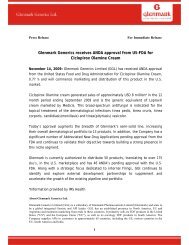Download - Glenmark
Download - Glenmark
Download - Glenmark
You also want an ePaper? Increase the reach of your titles
YUMPU automatically turns print PDFs into web optimized ePapers that Google loves.
In those cases where the possible outflow of economic resource as a result of present obligations is considered<br />
improbable or remote, or the amount to be provided for cannot be measured reliably, no liability is recognised in<br />
the consolidated statement of financial position.<br />
Any reimbursement that the Group can be virtually certain to collect from a third party with respect to the<br />
obligation is recognised as a separate asset. However, this asset may not exceed the amount of the related<br />
provisions. All provisions are reviewed at each reporting date and adjusted to reflect the current best estimate.<br />
Possible inflows of economic benefits to the Group that do not yet meet the recognition criteria of an asset are<br />
considered contingent assets.<br />
3.20 SHARE BASED COMPENSATION<br />
All employee services received in exchange for the grant of any share-based compensation are measured at<br />
their fair values. These are indirectly determined by reference to the fair value of the share options awarded.<br />
Their value is appraised at the grant date and excludes the impact of any non-market vesting conditions (for<br />
example, profitability and sales growth targets).<br />
All share-based compensation is ultimately recognised as an expense in income statement with a corresponding<br />
credit to additional paid-in capital, net of deferred tax where applicable. If vesting periods or other vesting<br />
conditions apply, the expense is allocated over the vesting period, based on the best available estimate of the<br />
number of share options expected to vest. Non-market vesting conditions are included in assumptions about the<br />
number of options that are expected to become exercisable. Estimates are subsequently revised, if there is any<br />
indication that the number of share options expected to vest differs from previous estimates.<br />
No adjustment is made to expense recognised in prior periods if fewer share options ultimately are exercised<br />
than originally estimated. Upon exercise of share options, the proceeds received net of any directly attributable<br />
transaction costs up to the nominal value of the shares issued are allocated to share capital with any excess<br />
being recorded as additional paid-in capital.<br />
4. ESTIMATION UNCERTAINTY<br />
The preparation of these consolidated financial statements is in conformity with IFRS and requires the application of<br />
judgement by management in selecting appropriate assumptions for calculating financial estimates, which inherently<br />
contain some degree of uncertainty. Management estimates are based on historical experience and various other<br />
assumptions that are believed to be reasonable in the circumstances, the results of which form the basis for making<br />
judgements about the reported carrying values of assets and liabilities and the reported amounts of revenues and<br />
expenses that may not be readily apparent from other sources. Actual results may differ from these estimates under<br />
different assumptions or conditions.<br />
All accounting estimates and assumptions that are used in preparing the financial statements are consistent with the<br />
<strong>Glenmark</strong>’s latest approved budgeted forecast, where applicable. Although these estimates are based on the best<br />
information available to management, actual results may ultimately differ from those estimates.<br />
Estimates of life of various tangible and intangible assets, and assumptions used in the determination of employee<br />
-related obligations and fair valuation of financial and equity instrument, impairment of tangible and intangible assets<br />
represents certain of the significant judgements and estimates made by the management.<br />
Useful lives of various assets<br />
Management reviews the useful lives of depreciable assets at each reporting date, based on the expected utility of<br />
the assets to the Group. The carrying amounts are analysed in notes 3.7 and 3.9. Actual results, however, may vary<br />
due to technical obsolescence, particularly relating to Internally generated intangibles and software.<br />
Post employment benefits<br />
The cost of post employment benefits is determined using actuarial valuations. The actuarial valuation involves<br />
making assumptions about discount rates, expected rate of return on assets, future salary increases and mortality<br />
rates. Due to the long term nature of these plans such estimates are subject to significant uncertainty.<br />
Fair value of financial instruments<br />
Management uses valuation techniques in measuring the fair value of financial instruments where active market quotes<br />
are not available. Details of the assumptions used are given in the notes regarding financial assets and liabilities.<br />
In applying the valuation techniques, management makes maximum use of market inputs and uses estimates and<br />
assumptions that are, as far as possible, consistent with observable data that market participants would use in pricing<br />
the instrument. Where applicable data is not observable, management uses its best estimate about the assumptions<br />
that market participants would make. These estimates may vary from the actual prices that would be achieved in an<br />
arm’s length transaction at the reporting date.<br />
Impairment<br />
An impairment loss is recognised for the amount by which an asset’s or cash-generating unit’s carrying amount<br />
exceeds its recoverable amount. To determine the recoverable amount, management estimates expected future cash<br />
flows from each asset or cash-generating unit and determines a suitable interest rate in order to calculate the present<br />
value of those cash flows. In the process of measuring expected future cash flows, management makes assumptions<br />
about future operating results. These assumptions relate to future events and circumstances. The actual results may<br />
vary, and may cause significant adjustments to the Group’s assets.<br />
Annual Report 2010-2011 91



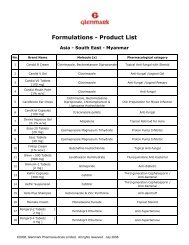



![Formulations [India] â Product List - Glenmark](https://img.yumpu.com/46601329/1/190x245/formulations-india-a-product-list-glenmark.jpg?quality=85)
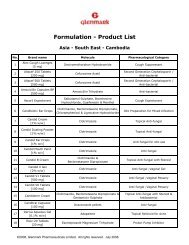
![Formulation [India] â Product List - Glenmark](https://img.yumpu.com/44013338/1/190x245/formulation-india-a-product-list-glenmark.jpg?quality=85)


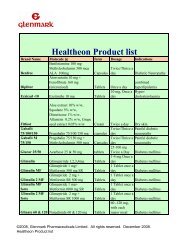
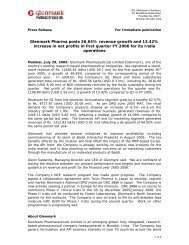
![Formulations [India] â Product List - Glenmark](https://img.yumpu.com/35994839/1/190x245/formulations-india-a-product-list-glenmark.jpg?quality=85)
